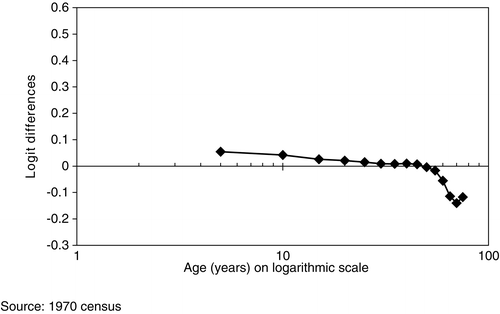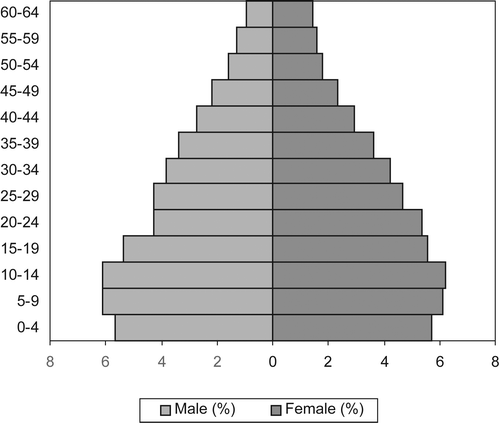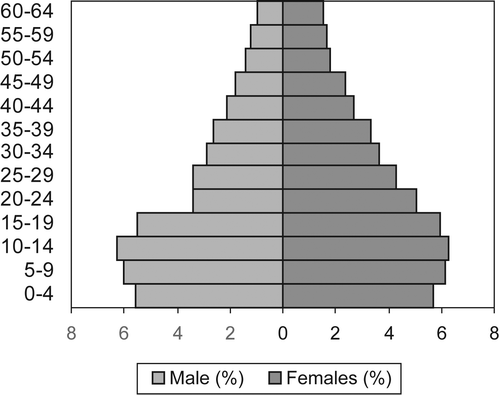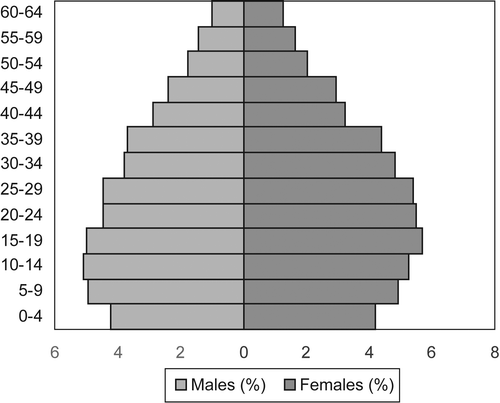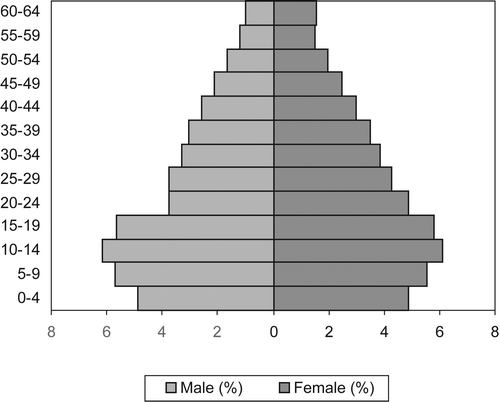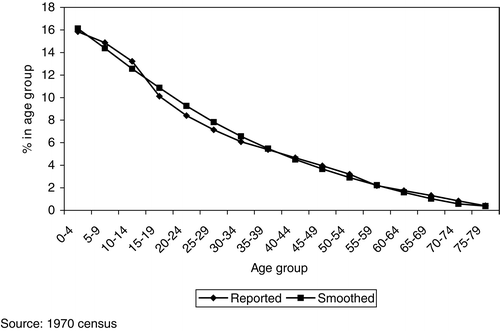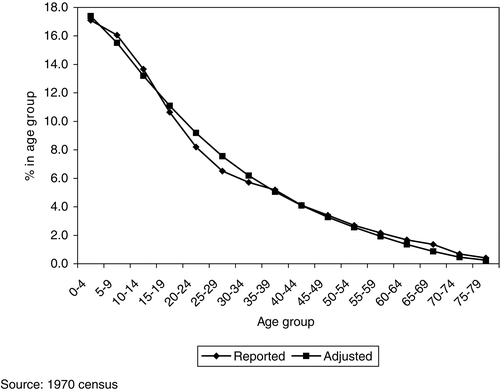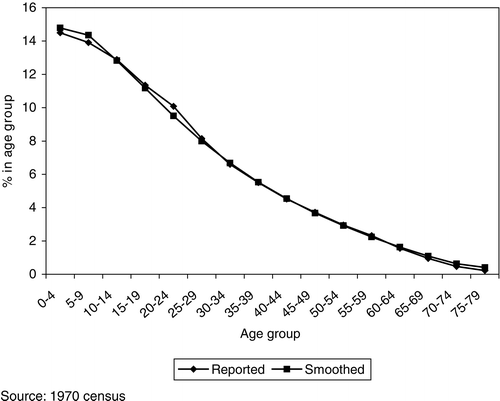Abstract
Knowledge about the age–sex distribution of a population is valuable for planning and decision making as it is a determinant of the future development of the population. Various aspects of the age–sex distributions of the population of South Africa estimated by Statistics South Africa remain controversial. For example, at face value the 1996 census implies that the overall sex ratio dropped from 97 in 1970 to 92 in 1996 and 91 in 2001. The 1996 census results also imply that the proportion of peoples aged 0–4 dropped from 15 per cent in 1970 to 11 per cent in 1996 and 10 per cent in 2001. In an attempt to shed more light on these controversies this study evaluates the age–sex distributions from the 1996 census, using a novel approach, and also develops model age–sex distributions for South Africa as a means of evaluating age–sex distributions from the 2001 census, and future censuses and surveys in the country.
1. Introduction
The age–sex distribution of a population is a cross-cutting variable in planning, as it is intrinsically linked to all aspects of the life cycle, including childhood, education, marriage, childbearing, entry into the labour market, retirement, ageing, morbidity and mortality. Knowledge about the age–sex distribution of a population is therefore valuable information for planning and decision making, as it is also a determinant of the future development of the population. Planning and policy decision can be impaired if information about the age–sex distribution of the population is inaccurate. For example, in the education sector incomplete coverage of people in certain age groups in a census, if not corrected for, can result in the school-aged population being underestimated in population projections, which may result in inadequate allocation of resources in planning for this sector. Similarly, incomplete coverage of people in certain age groups by sex (e.g. the 0–4 or 20–24 groups) in a census, if not corrected for, could lead to erroneous conclusions about the impact of HIV/AIDS, which might affect planning in the health sector. It is therefore essential to appraise age–sex distributions from a census or survey to accurately inform planning and decision making.
Various aspects of the age–sex distributions of the population of South Africa estimated by Statistics South Africa Citation(1999) from the 1996 census remain controversial (Dorrington, Citation1999; Phillips et al., Citation1999; Sadie, Citation1999; Shell, Citation1999; Udjo, Citation1999). The following are two of these controversial issues. First, at face value the 1996 and 2001 censuses imply that the overall sex ratio dropped from 97 in 1970 to 92 in 1996 and 91 in 2001. Second, the results of the censuses imply that the proportion of people aged 0–4 dropped from 15 per cent in 1970 to 11 per cent in 1996 and 10 per cent in 2001. As an attempt to shed more light on these controversies, this study evaluates the age–sex distributions from the 1996 census, using a novel approach that has hitherto not been undertaken. Also, the study develops model age–sex distributions for South Africa as a means of evaluating age–sex distributions from future censuses and surveys in the country.
2. Conceptual problem in evaluating age–sex distributions
An age–sex distribution is determined by past fertility, mortality and migration. Perhaps the most disturbing problem in the evaluation of age–sex distributions is migration. International and internal migration data are both problematic. First, documented international migration (emigration and immigration) at any point in time may be incomplete because people may not declare their intentions on entry or exit at the designated entry/exit points. Second, because national borders are porous, the magnitude of undocumented migrants who may be residing in a country is generally unknown. This poses a problem when evaluating age–sex distribution at the national level, as it is difficult to ascertain whether or not certain observed features in age–sex distributions are due to international migration. Third, few countries in the world track internal migration through a system of population registers. Although internal migration data may be available from surveys and censuses, the accuracy of such data is often in doubt, thus limiting age–sex evaluation at the subnational level.
These problems exist in varying degrees in South Africa. For example, with regard to documented emigration, the official figures are unreliable. Estimates of the ratio of South African emigrants (reported in major receiving countries) to South Africa's Home Affairs figures is 1.4 for the period 1970–96 (Bah, Citation1999); 2.8 for the period 1989–97 (Kaplan et al., Citation1999); and 1.4–4.7 (Interim Statistics Council, Citation1998). Additionally, the scale of undocumented immigration (presumably largely African) is unknown. McDonald et al. Citation(1999) and Brunk Citation(1996), for example, quote some figures that have been speculated. Crush (Citation1999; cited in McDonald et al., Citation1999) also provides some figures. These range from half a million to eight million. In view of this, it is extremely difficult to assess and control for the impact of migration when evaluating age–sex distributions of South Africa's population.
One approach in controlling for migration is to exclude non-South African citizens from the analysis. This approach is, however, unsatisfactory because of uncertainty surrounding the accuracy of available figures. With regard to the 1996 census for example, a total of 369 950 (i.e. 1 per cent of the total population) were reported as non-South Africans. This figure is negligible but has been contested by a number of researchers as an underestimate. It has been argued, for example, that a process of ‘self-naturalisation’ among undocumented immigrants may have been at play during enumeration in the 1996 census for fear of repatriation (Interim Statistics Council, Citation1998).
In view of the uncertainty about the volume of migration, migrants were not excluded from the analysis in this study. Hopefully, the volume of net international migration and its impact on the age–sex structure in South Africa are relatively negligible in comparison with the other demographic processes. It is possible, however, that this study underplays the impact of net international migration on the age–sex distributions.
3. Data
The sources of data for this study are the 1970 (see Republic of South Africa, Citation1976) and 1996 (see Statistics South Africa, Citation1999) censuses, and the 1998 October Household Survey (OHS98) (see Statistics South Africa, Citation2000).
3.1 The 1970 and 1996 censuses
The 1970 and 1996 censuses were chosen for this study for the following reason. The 1970 census was the last census during the apartheid era that canvassed the entire country, while the 1996 one was the first post-apartheid nationwide census. The censuses between these two periods were fragmentary in the sense that they did not canvass the entire country. While the 1970 census had an estimated undercount of about 2 per cent (Sadie, Citation1988), the 1996 census had an estimated undercount of about 11 per cent.
The census questionnaires in both the 1970 and 1996 censuses included the pertinent variables for this study – age, sex and population group (African/black, coloured, Indian and white). In addition, the 1996 census had information on region of residence – province – as defined in the post-apartheid era, which is different from regional boundaries in the apartheid era. The estimated population in 1970 was 22.1 million (Sadie, Citation1988), while it was estimated as 40.6 million in 1996 (Statistics South Africa, Citation1999). Because of the controversies surrounding the adjustments of the 1996 census (and which has resurfaced in recent years), the analysis in this study using the 1996 censuses was based on the unadjusted figures.
3.2 1998 october household survey
Statistics South Africa began a programme of October Household Surveys in 1994. Until 1998, they were omnibus surveys. On the basis of this author's assessment of various aspects of quality in these surveys (Udjo, Citation1997, Citation1998, Citation2003), of all the October Household Surveys the 1998 survey is the most appropriate for this study.
The sample size for the 1998 survey was 20,000 households. Although a probability sample, it was not self-weighting nationally. Analysis of the data was therefore carried out at levels (population group, place of residence) where they were roughly self-weighting. Hirschowitz & Orkin Citation(1996) provide details about the design of the October Household Survey.
4. Methods
The analysis in this study is based on the following premise. In a closed population, the sex ratio in specified age categories derived from the listing of household members should be equal to that derived from mothers residing in the household reporting on the number of children alive and living with the mother at the time of enumeration, in the absence of errors in both sets of report. While the listing of members of households is often obtained from the head of household (or someone acting in that capacity), in a census or survey household questionnaire/schedule, it is often obtained from birth histories in a survey questionnaire. Comparison of sex ratios in specified age categories derived from both sets of data can be used to appraise the quality of either or both sets of data.
Careful consideration must be given to the choice of the age categories on which the sex ratios are based. This is because the age–sex reports from the household questionnaire span the entire age range in the population, while the age–sex report on children alive (and living with the mother) from birth histories only covers a maximum age that is about 15 years lower than that of the oldest mother living in the household listed in the household schedule.
In theory, the people in birth histories are the sons and daughters of mothers listed in the household and, if alive and living with the mother, would comprise a substantial component of those listed in the household. On the other hand, people listed in household can be categorised broadly into the following: (1) non-family members (e.g. visitors, domestic workers); (2) sons and daughters of the household head and/or his/her partner; and (3) other family members (e.g. head of household, wife/husband/partner, father of head of household, etc. In general, (1) above is numerically small compared to (2) and (3). In developing countries generally, children (or people under the age of 15) constitute a very substantial part of the population. Thus in any population a strong driving force in sex ratios in certain age groups is the second component above (i.e. sons and daughters of household head and/or his/her partner).
If there is no marked trend in sex ratios (owing to trends in sex ratio at birth, differential mortality and migration by sex) in the population, sex ratios in certain age groups derived from a household schedule in a survey/census should be approximately similar to the sex ratios derived from the birth histories in the same survey. Sex ratios usually do not show a marked trend in a short period of time (for instance, five to ten years).
Sources of discrepancy in the sex ratios from both sets of reports and over time, may arise from one or more of the following: (1) differential coverage by sex; (2) magnitude of, and changing pattern of age/sex differential in mortality; (3) differential pattern of age misreporting by sex; and (4) changing pattern of migration by sex.
As noted, migration is a complicating factor in the analysis of sex ratios. However, this is not important when assessing the quality of two sets of report from the same survey. If, however, one is comparing sex ratios from two data sources at different time periods, migration cannot be ignored, and it was controlled for in this study. Differential pattern of mortality and age misreporting were also controlled for, thus some of the results presented in this study are an indication of the magnitude of the discrepancy in sex ratios attributable mainly to differential coverage by sex.
Sex ratio computed as the number of males per 100 females is a cross-cutting measure in this study. The effect of differential age misreporting on sex ratios was minimised by computing the ratios for broad age groups (less than 15 years, 15–64 and 65 + age groups). An overall ratio was also computed for people aged 0–64. The choice of 64 as the upper age limit was based on the following consideration. Because no upper age limit was imposed on women to whom the birth histories were administered in the 1998 survey, the children in their 70s at the time of the survey would have been born of mothers in their late 80s at the time of the survey. However, to minimise the effect of random fluctuation due to small numbers in the survey and to make the sex ratio in the birth history comparable to that obtained from the household schedule, an upper age limit of 64 was imposed (note that the age band 0–64 covers about 95 per cent of South Africa's estimated population). To minimise the effect of migration at the household level, the computation of sex ratios from the birth histories was restricted to children alive and living with the mother at the time of the survey so that it is comparable to the sex ratio obtained from the household schedule. In the presentation of the results, the sex ratio from birth histories relates to children alive and living in same household as the mother at the time of the survey. Note that sinasce censuses (with a few exceptions, e.g. those in Namibia) do not collect birth histories, sex ratios from birth histories relate only to the 1998 October Household Survey.
Smoothing of the reported 1970 age–sex distributions was carried out by comparing the logit transformations of the reported cumulated age–sex distribution with an appropriate stable population. The selection of the stable populations was based on the similarity of estimated parameters (including the general fertility rate, proportions under the age of 15 and 45+, life expectancy at birth and the rate of population growth) of the observed population in comparison with those of the stable population (see Carrier & Hobraft, Citation1971 for the construction of the stable populations).
The logit transformations, Yx and Ysx given by Brass Citation(1971) are denoted:
Where yx is the cumulated proportion under age x in the observed population. The subscript s denotes the stable population. The Yx values were plotted against the Ysx values and a straight line fitted to the ‘best’ points using the ordinary least-squares method.
The smoothed age distribution, Yx′ was computed as:
where the terms on the right hand define the fitted line. Retransformation of the fitted values was obtained using the expression:
where Yx′t is the antilogit of Yx′. Yx′t was decumulated to obtain the smoothed proportion of people in age group x. This proportion was then applied to the total number of people (by sex) adjusted (by Sadie, Citation1988) for undercount in the census to obtain the smoothed number of people in age group x.
The AIDS impact model (AIM) developed by the Futures Group was used to incorporate the impact of HIV/AIDS in the population estimates. The method is described by Stover & Kirmeyer Citation(1999). Estimation of the basic parameters required by AIM was based on the following assumptions. First, it was assumed that the Nelson Mandela/HSRC Citation(2002) data provide a reasonable measure of HIV seroprevalence at the national level and hence the Department of Health's antenatal seroprevalence for the period 1990–2001, calibrated by Rehle & Shisana Citation(2003), provide a reasonable measure of national adult HIV seroprevalence for the period 1990–2001. Second, it was assumed that the distribution of national adult HIV seroprevalence by population group in 2002 as measured by the Nelson Mandela/HSRC study is similar to the distribution of adult seroprevalence by population group in previous years. On this basis, the ratio of the adult HIV seroprevalence of each population to the total adult prevalence in 2002 was used as weight on the prevalence for each year to obtain an estimate of each population group for each year during the period 1990–2002. Lastly, it was assumed that the age-specific seroprevalence among adults in the Nelson Mandela/HSRC data is similar for all population groups and is a reasonable measure of age-specific seroprevalence in 1990–2002.
Immigration and emigration statistics are available from the Department of Home Affairs through Statistics South Africa for the estimation period (1970–2001). However, these statistics are not given by population group, and the number of documented emigrants appears to understate the true extent of the phenomenon as already noted. In view of this, net migration was estimated assuming that: (1) the number of documented immigrants is accurate; (2) the percentage distribution of documented immigrants by population group is similar to the percentage distribution of non-South Africans by population group and sex as reported in the 1996 census (although the number may not be accurate); (3) the number of documented emigrants is inaccurate; (4) prior to 1994, the percentage distribution of documented emigrants by population group is similar to the percentage distribution of non-South Africans by population group as reported in the 1996 census; and (5) the age distribution of documented immigrants for the period 1996–2001 is a reasonable estimate of the age distribution of net migrants for the estimation period.
On the above basis, the documented volume of immigration during the period 1970–2001 was split by population group and sex. Regarding emigration, a correction factor of 1.4 was used to adjust the documented number of male–female emigrants for the period 1970–93, while for the period 1994 to 2001 a correction factor of 2.7 was applied (Bah, Citation1999; Kaplan et al., Citation1999). The adjusted figures for the period 1970–93 by sex were then split by population group on the basis of the above assumptions. The adjusted figures by sex for the period 1994 to 2001, however, were attributed to the white population. An average of the male–female age distribution of documented immigrants for the period 1996–2001 was used as the best estimate of net migrants for the entire estimation period.
5. Results
5.1 Internal evaluation of the overall sex ratio from the 1998 survey
Some researchers (Dorrington, Citation1999; Sadie, Citation1999) have argued that the overall sex ratios from the 1996 census are too low and indicative of a general under-enumeration of males during the census.
The first panel of shows a consistent difference in the overall ratio (i.e. for people aged 0–64) as reported in the household schedule and the birth history in the 1998 October Household Survey among the four population groups. The ratios are lower in the household schedule compared with the birth history, with Africans showing a very low sex ratio. Because the two sets of reports were obtained in the same survey, the difference cannot be attributed to migration or differential pattern of age–sex mortality but point to differential coverage (which could be in either direction) in either set of data. While the ratios from the birth histories are close to 100 in the four population groups, and similarly among Indians and whites in the household schedule, among Africans and coloureds the ratios are much lower than 100 in the household schedule. This appears to suggest under-reporting of males in the household listing, especially among the African population during the 1998 survey. An alternative interpretation is overstatement of female Africans especially, owing to misstatement of sex.
Table 1: Reported sex ratios in broad age groups in 1998 and 1996 by population group
Further decomposition of the sex ratios of the 0–64 age band revealed that the main source of the discrepancy in the sex ratios derived from the household scheduled compared with those derived from the birth history is in the sex ratio of the 15–64 age group. Among Africans for example, the sex ratio of the 15–64 age group is 82 in the household schedule compared to 97 in the birth history (see the third panel of ). The high sex ratio for the 15–64 age group from the birth histories of Indian women is due probably to selective omission of dead females in their reports.
Four of the nine provinces (the Eastern Cape, Kwazulu-Natal, Limpopo and Mpumalanga) also exhibit substantial inconsistencies in the sex ratios of people aged 0–64 derived from the household schedule compared with those derived from the birth history of the 1998 survey (see ). The sex ratios from the household schedule are very low (owing to the low sex ratios in the 15–64 age group). In Limpopo province, for example, whereas the sex ratio for the 0–64 age group is 81, the corresponding value from the birth history is 104. This inconsistency may not be attributable to migration, since the two sets of information were collected from the same unit of enumeration in the same survey. It appears from this that the apparent under-enumeration of males (or overstatement of the number of females) in the household listing during the 1998 survey was more marked in the Eastern Cape, Kwazulu-Natal, Limpopo and Mpumalanga than in the other provinces.
In these provinces there are also marked discrepancies in the sex ratios of the 0–64 age group derived from the birth histories of the 1998 survey compared with the ratios derived from the 1996 census for the same age group, which may not be attributed to migration. If the discrepancies were due to migration, one would expect low sex ratios of the 15–64 age group obtained from the birth histories but this is not case, as the birth histories indicate much higher sex ratios in the 15–64 age group compared with those obtained from the 1996 census for the same age group in each of the provinces. (It is unlikely that there could have been systematic reverse migration in two years).
5.2 Consistency of reported overall sex ratios over time as a means of evaluating the sex ratios from the 1996 census
As shown in the first panel of , the overall sex ratios (0–64 age group) from the 1996 household members list among Africans and coloureds are inconsistent with those from the birth histories of the 1998 survey and the 1970 census, especially among Africans. Among Africans, the reported ratio was 98 and 93 in the 1970 and 1996 censuses, respectively, and 99 from the birth history of the 1998 survey. It is inconceivable that demographic processes (i.e. fertility, mortality and migration) resulted in a sharp decline in the sex ratio from a high of 98 in 1970 to a low of 93 in 1996. The ratio from the birth history of the 1998 survey is consistent with the ratio in 1970. The low ratio from the 1996 census could be due either to under-enumeration of the number of males or overstatement of the number of females owing to misclassification of sex during the listing of household members in the 1996 census.
Under-enumeration of male or over-enumeration of female Africans and coloureds during the 1996 census appears to have been marked in the working age group compared to the other age groups (see the last two panels of ).
5.3 The 0–4 age group
Indentation at the base of the population pyramid is a consistent feature of reported age–sex distributions in various household surveys and censuses undertaken by Statistics South Africa. and appear to suggest that the proportion aged 0–4 increased by more than 1 per cent between 1995 and 1996. Furthermore, and show marked differences in the age–sex distributions in two different surveys that were undertaken in 1997. Both pyramids appear to suggest that within the same year (i.e. in 1997), the proportion aged 0–4 changed by nearly 3 per cent. Comparing and , one would expect that the reported cohort 0–4 years old in 1995 (9.6 per cent) would 5 years later in 2000 move to the cohort 5–9 years old and, taking account of mortality, the proportion aged 5–9 in 2000 would be less than 9.6 per cent in the absence of large scale immigration in this particular age group (i.e. 5–9 in 2000). In contrast, the reported proportion aged 5–9 in 2000 (11.2 per cent) is higher than the reported proportion aged 0–4 in 1995 (9.6 per cent). These patterns are not consistent with fertility trends in South Africa.
The ratio of the 0–4 and 5–9 groups can be used to evaluate the accuracy of the reported proportions aged 0–4 in the 1998 survey and the 1996 census. In view of levels and trends in fertility in South Africa (Udjo, Citation2003), the ratio of the 0–4 and 5–9 age groups should be greater than unity among Africans and coloureds in 1998 and 1996. A ratio of these age groups less than unity is therefore indicative of the minimum extent of under-reporting of the 0–4 age group in a particular year (unless mortality was higher among children 0–4 compared to children of similar age five years before). With regard to whites and Indians, one would expect a ratio less than but close to unity in view of their low levels of fertility over the years.
As seen in , overall, the ratio is less than unity in the 1996 census (0.93) and 1998 household members listing (0.88). The ratio by population group is also less than unity except among Indians in the 1998 household members listing. The ratios are questionable in the 1996 census data even among Indians and whites (0.88 and 0.87 respectively). The ratio in Sweden, Switzerland and the United Kingdom (which are among the countries with the lowest fertility in the world) were, respectively, 1.0, 0.91 and 0.99 in 1995. A three-parameter stable population model chosen on the basis of fertility, mortality and rate of population growth in South Africa, as estimated by this author (Udjo, Citation1998, Citation2003) for the period under consideration, suggests a ratio of 1.11 for the population.
Table 2: Ratio of 0–4 to 5–9 age group by population group and province
The stable population model suggests that under-reporting of people aged 0–4 relative to people aged 5–9 at the time of the 1996 census may have been in the region of 18 per cent. The bottom panel of in comparison with the stable population model suggests that under-reporting of the 0–4 age group relative to the 5–9 age group in the Eastern Cape, the Free State and Limpopo provinces in the 1996 census was probably over 20 per cent. The under-reporting may be due partly to age shifting.
6. Model age–sex distributions
The UN age–sex accuracy, Whipple's and Myers' blended indices are commonly used methods for evaluating the quality of reported age–sex distributions (see Shryock et al., Citation1976). These are summary overall measures of quality which do not provide detailed insights into the quality of the reports. Detailed insights can be gained from single or five-year population pyramids aided by demographic modelling. The demographic models constructed as further means of evaluating the age–sex distributions consisted of model age distributions for the different population groups on the basis of the smoothed 1970 census age–sex distributions which were then projected to 2001 on the basis of the fertility and mortality estimates provided by this author (Udjo, Citation1998, Citation2003) without the impact of migration and HIV/AIDS. Similarly, the smoothed 1970 census age–sex distributions by population group were projected incorporating migration and HIV/AIDS. Both sets of projections can be used to evaluate the quality of the reported 1996 and age–sex distributions from future surveys and censuses.
Appendices 1–2 show the differences between the logits of the observed and standard percentages under specified ages. The plots for Africans and coloureds are more or less inverted C-shaped, indicating the presence of errors in the reported male and female age distributions (female plots not shown) hence the need for smoothing. If there were no errors, the points would form almost a straight line. On the other hand, the plots for Indians and whites are almost a straight line except at the extreme old ages (Appendices 3–4), suggesting better quality of the age–sex reports (female plots not shown) among Indians and whites. The almost horizontal line in the plots for whites, except at the extreme old ages (Appendix 4), suggests that the age distribution of whites was already considered approximately stable in 1970.
The reported and smoothed age distributions are shown in Appendices 5–8. Note that the smoothed age distributions do not fit very well at the two oldest age groups among whites (Appendix 8), but this is of very little significance as these age groups numerically constitute less than 3 per cent of the white population and are either near or at the terminal ages at which people exit the population.
Appendices 9–13 compare the smoothed five-year age–sex distributions projected to 2001, with the reported age–sex distributions in the 1996 census by population group, and a summary of the results in broad age groups is given in . As can be seen in , the 1996 model sex ratios are higher than corresponding sex ratios reported and adjusted by Statistics South Africa (see bottom panel of , columns 3, 5 and 7). The difference arises largely from the sex ratio of the 15–64 age group in the African population and, to a lesser extent, the coloured population (see first two panels of , columns 3, 5 and 7).
Table 3: Reported and model age distributions without HIV/AIDS and migration, 1996 and 2001
In general, the reported and Statistics South Africa's adjusted 1996 census results suggest an apparent deficit of males relative to females in the African and coloured populations that is inconsistent with the parameter estimates of demographic processes among Africans and coloureds as seen from the results of the model estimates.
Also, the reported and Statistics South Africa's adjusted 1996 census appear to understate the 0–4 age group, as the proportion is inconsistent with the parameter estimates of demographic processes of the population. Among Africans, for example, the ratio of the 0–4 and 5–9 age groups in 1996 was about 0.96 in the adjusted results of the Census, and the present model suggests a ratio of 1.10, while a figure of 1.02 was derived from the 1998 October Household Survey birth history. A simulation model also suggests that if present levels and trends in fertility and mortality continued, marked indentation at the base of the pyramid of the African population would not occur before 2010. The model estimates for 2001 for the parameters described above are similar to those for 1996 and thus may be used in evaluating the 2001 census results, as discussed in the last section of this paper.
7. Effects of HIV/AIDS and migration
Theoretically, the effects of HIV/AIDS and positive net migration on age distributions operate in opposite directions. While AIDS deaths in populations with a generalised HIV epidemic reduce the relative proportions in certain age groups, large-scale positive net migration should increase the relative proportions in certain age groups. Furthermore, because HIV seroprevalence is generally higher for females than males in populations characterised by heterosexual transmission (such as in South Africa), this should lower age-specific sex ratios in certain age groups and also the overall sex ratio in populations with high HIV prevalence at some future date. On the other hand, as migration is sex-selective, positive net migration could counter the effect of HIV/AIDS on age-specific sex and overall sex ratios. shows the effect of HIV/AIDS and migration on South Africa's age distributions. As seen in the table, there is no evidence from the model estimates to suggest that the combined effect of net migration and HIV/AIDS is altering sex ratios substantially in South Africa's population at present.
Table 4: Statistics South Africa adjusted and model age–sex distributions, taking account of migration and HIV/AIDS by population group in 1996 and 2001; Stats SA adjusted 1996
8. Discussion and conclusion
An apparent deficit of males was noted in the reported and adjusted 1996 census results among Africans and coloureds that is inconsistent with: (1) the parameter estimates of demographic processes in the populations and (2) the OHS98 birth history reports. It could be argued from the results of this study that the apparent deficit of males may have resulted from overstatement of the number of females in household member listings in certain age groups. Several factors may be at play for the overstatement of females.
First, age-shifting may be part of the explanation. For example, at face value the first panel of would suggest that virtually all Africans in 1996 were in the age group 0–64, as virtually less than 0.1 per cent were reported aged 65 and above. On the other hand, the model estimates suggest that about 3 per cent of the African population were probably in the age group 65 and over, implying that in the household member listing the age of these people was shifted downward to the 15–64 age group. Although Statistics South Africa corrected for this shift (see top panel of , column 4) in the final result of the census, the direction of the correction is debatable for the following reasons. Presumably, women are more likely to understate their age and this should be taken into consideration. However, it would appear this was not given sufficient consideration in Statistics South Africa's adjustment as it only raised the ratio of the 15–64 age group from 90 to 0.91 compared with 97 from the model, and birth history of the 1998 survey.
Second, overstatement of females could arise from misstatement of sex in the household member listing and this may be culturally rooted. For example, a colleague has suggested that linguistically the masculine is sometimes interchanged with the ‘feminine’ in day-to-day discourse. This author recalls his (anecdotal) experience in Botswana: some Tswana would sometimes refer to him as ra and shortly after as ma. While the first term is usually used with reference to the male, the second is supposed to refer to a female. It is probable that the feminine is sometime used interchangeably with the masculine among Africans in South Africa. This requires further investigation.
The results from this study suggest that the age–sex distribution from the household listing of the October Household Surveys (OHS) and the 1996 may not be reliable, especially among the African population. The OHS98 birth history appears to provide a better indicator of sex ratios. It is not clear why the mothers would report sex more accurately in the birth histories than sex in the household member listing.
Reported differences in the absolute number of males and females in absolute terms based on the household member listing in the October Household Surveys (now replaced by the General Household Survey) and the 1996 census need re-examination, as such differences have implications for unadjusted indicators derived from such data. It is probable, for example, that the pattern of age shifting noted above, combined with probable exaggeration of the number of females in the 15–64 age group (i.e. in the labour market) may have, to some extent, biased previous female and overall unemployment ‘rates’ upward, as the ‘total number of cases existing at a particular point in time’ (i.e. unemployed) may have been exaggerated.
The results of this study also suggest that the 0–4 age group is understated in Statistics South Africa's data sets, including the final results of the 1996 census. In the light of this, reliance on these data for certain kinds of planning (for example, in the education sector) is likely to be misleading.
In view of the above, caution should be exercised in producing estimates of male–female differences in indicators from the 2001 census and future household surveys. The above estimates provide a valuable tool for evaluating the age–sex distributions from the 2001 census results. As seen from the last two panels of , certain aspects of the age–sex distributions from the 2001 census are inconsistent with the model estimates. Notably, the ratio of the 0–4 and 5–9 age groups is lower in Statistics South Africa's adjusted 2001 census figures than in the model estimates among Africans, Indians and whites. This suggests underestimation of the 0–4 age group in Statistics South Africa's adjusted figures. Also, the model estimates appear to suggest that overall sex ratios in Statistics South Africa's figures are too low among Africans and coloureds. These seemingly low overall sex ratios are attributable to the apparent low sex ratios of Africans and coloureds in the labour market.
In the past, the low sex ratios from Statistics South Africa's data sets have often been interpreted as indicating ‘missing males’. This apparent ‘missing males’ is probably due to overstatement of females in household member listing in the 1996 census. Because the 1996 census final results have been used for deriving weights for sampling and subsequently weighting of survey data, the errors in sex ratios are carried over to the survey data (and indicators derived from them), as sex is either used as an explicit or implicit stratification variable in sampling and weighting. Lastly, the combined effect of net migration and HIV/AIDS appears to have very little impact on overall sex ratios presently in South Africa.
Acknowledgments
The author wishes to thank Statistics South Africa for providing access to its data for this study. The views expressed in this paper are those of the author and do not necessarily reflect those of Statistics South Africa or the Human Sciences Research Council.
Additional information
Notes on contributors
Eric O Udjo
Research Director, Epidemiology and Demography Unit, Social Aspect of HIV/AIDS and Health, Human Sciences Research Council (HSRC), Pretoria.References
- Bah , S . 1999 . “ A comparative assessment of independent sources of migration data: the case of the South African residents and citizens who have emigrated to five leading destination countries ” . Pretoria : Statistics South Africa, Mimeograph .
- Brass , W . 1971 . Methods for estimating fertility and mortality from limited and defective data , Chapel Hill, NC : University of North Carolina .
- Brunk , M . 1996 . “ Undocumented migration to South Africa: more questions than answers ” . Cape Town : IDASA (Institute for Democracy in South Africa . Public Information Series No. 1
- Carrier , N and Hobcraft , J . 1971 . Demographic estimation for developing societies , London : Population Investigation Committee .
- Crush , J . 1999 . The dimensions of irregularity in post-apartheid South Africa. International Migration , Oxford : Blackwell .
- Department of Health . 2002 . National HIV and syphilis antenatal seroprevalence survey in South Africa 2002 , Pretoria : Department of Health .
- Dorrington , R . To count or to model that is not the question: Some possible deficiencies with the 1996 census results . Paper presented at the Arminel Roundtable workshop on the 1996 South Africa Census, Hogsback . April 9–11 , Eastern Cape.
- Hirschowitz , R and Orkin , M . 1996 . Living in South Africa: findings from the October 1995 Household Survey , Pretoria : Central Statistical Service .
- Interim Statistics Council . 1998 . 1996 South Africa Census Review Committee , Pretoria : Statistics South Africa .
- Kaplan , D , Meyer , J and Mercy , B . 1999 . Brain drain: new data, new options . Trade & Industry Monitor , September: : 10 – 13 .
- McDonald , D , Mashike , L and Golden , C . 1999 . The lives and times of African migrants and immigrants in post-apartheid South Africa , Cape Town : IDASA (Institute for Democracy in South Africa) . Migration Policy Series No. 13
- Nelson Mandela/HSRC Study Of HIV/AIDS . 2002 . South African national HIV prevalence, behavioural risks and mass media household survey, 2002 , Cape Town : Human Sciences Research Council (HSRC .
- Phillips , H E , Anderson , B A and Tsebe , P . Sex ratios in South African census data 1970–1996 . Paper presented at the Workshop on Phase 2 of Census 1996 Review on Behalf of the Statistical Council . December 3–4 , Johannesburg.
- Rehle , T E and Shisana , O . 2003 . Epidemiological and demographic HIV/AIDS projections: South Africa . African Journal of AIDS Research , 2 ( 1 ) : 1 – 8 .
- Republic of South Africa . Department of Statistics, 1976. Single ages: 1941–1970 , Pretoria : Government Printer . Report No. 02–05
- Sadie , J L . 1988 . “ A reconstruction and projection of demographic movement in South Africa ” . Bureau of Market Research, University of South Africa .
- Sadie , J L . The missing millions . Paper presented to NEDLAC (National Economic Development and Labour Council) meeting . Johannesburg.
- Shell , R . An investigation into the reported sex composition of the South African population according to the census of 1996 . Paper presented at the Workshop on Phase 2 of Census 1996 review, Wanderers Club . Johannesburg. 3–4 sDecember
- Shryock HS, Siegel JS & Associates . 1976 . The methods and materials of demography , New York : Academic Press .
- Statistics South Africa . 1999 . The people of South Africa, population census 1996: primary tables, the country as a whole , Pretoria : Statistics South Africa .
- Statistics South Africa . 2000 . October Household Survey, 1998 , Pretoria : Statistics South Africa .
- Stover , J and Kirmeyer , S . 1999 . “ Research Triangle Institute, 1999 ” . In AIM: spectrum system of policy models , Washington, DC : Futures Group International .
- Udjo , E O . 1997 . Fertility and Mortality Trends in South Africa: the evidence from the 1995 October Household Survey, and implications on population projections , Pretoria : Central Statistical Service .
- Udjo , E O . 1998 . Additional Evidence regarding fertility and mortality trends in South Africa and implications for population projections , Pretoria : Statistics South Africa .
- Udjo , E O . Comment on R. Dorrington's ‘To count or to model that is not the question’ . Paper presented at the Arminel Roundtable Workshop on the 1996 South African Census . April 9–11 , Hogsback, Eastern Cape.
- Udjo , E O . 2003 . A re-examination of levels and differential in fertility in South Africa from recent evidence . Journal of Biosocial Science , 35 : 413 – 31 .
Appendix 1: Differences between logits of observed (1970) census and standard % under ages, male Africans
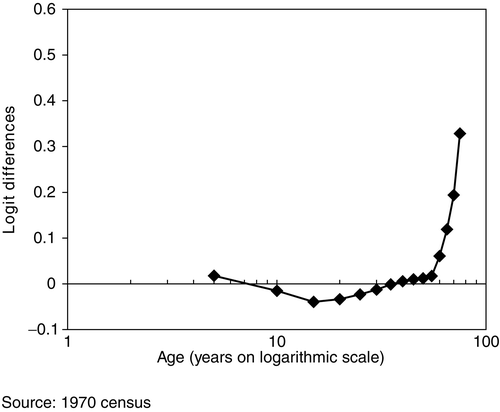
Appendix 2: Differences between logits of observed (1970) census and standard % under ages, male coloureds
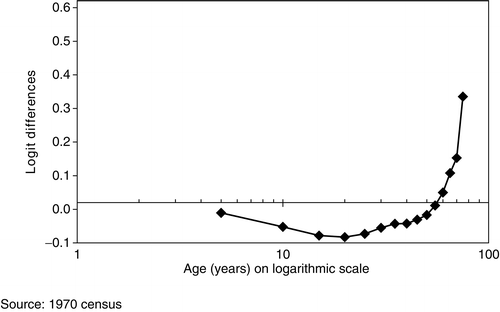
Appendix 3: Differences between logits of observed (1970) census and standard % under ages, male Indians
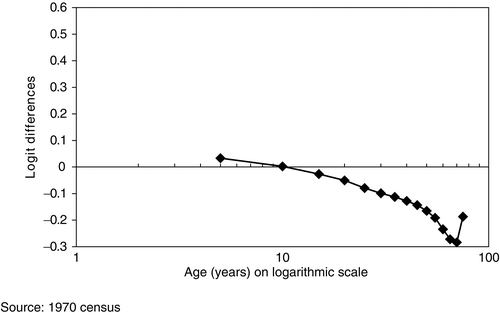
Appendix 4: Differences between logits of observed (1970) census and standard % under ages, male whites
